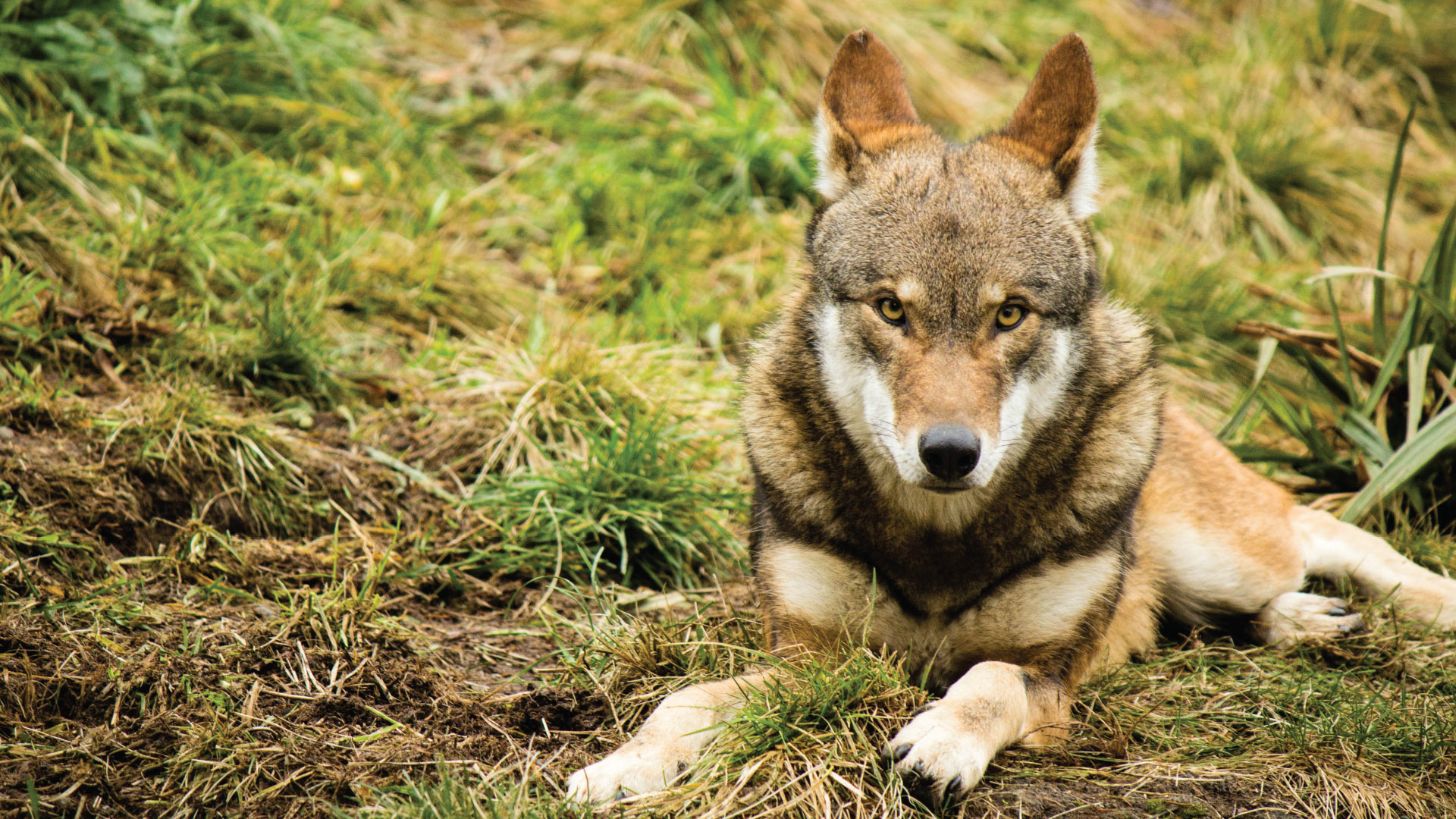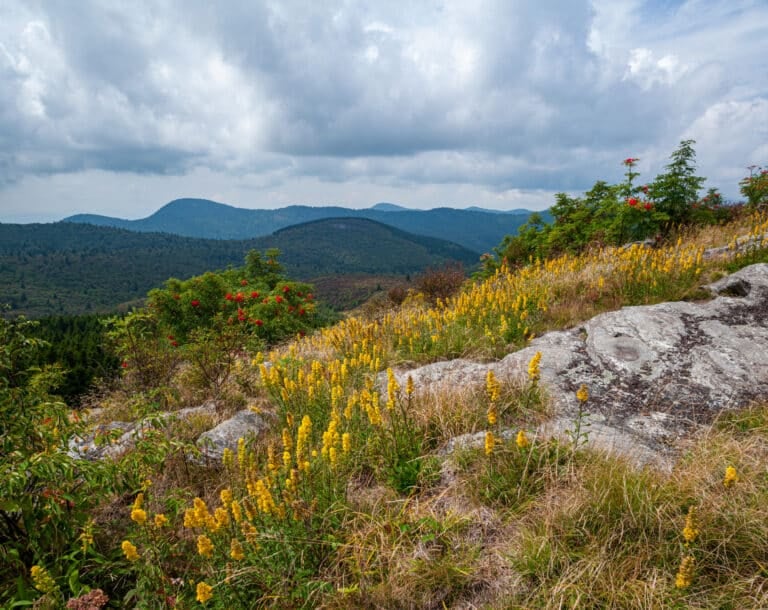The U.S. Fish & Wildlife Service guts protections for the last red wolves in the wild.
Ron Sutherland drove for hours through the Alligator River National Wildlife Refuge, alternately inching forward and braking to scan swaths of cropland as long as jetliner runways. He was determined to make a good stab at seeing a red wolf, but carried on a casual conversation, aware that his pursuit was an extreme long shot.
He then stopped talking mid-sentence and focused his binoculars at a couple of distant specks. “Two wolves. Score!” he says, rushing from behind the wheel for a better view. His lenses revealed a pair of German shepherd-sized animals, dark along the spine, copper-colored at the flanks and shoulders, with white patches under their jaws that were visible even from 200 yards away, even in the fading light of evening. Sutherland, a conservation scientist with the non-profit Wildlands Network, watched and photographed until nightfall as the wolves rooted for mice and then lay down to rest. Back in the car, he tried to put this sighting into perspective.
“If you think of this in the grand scheme of endangered species spotting, there’s probably 5,000 snow leopards and 2,000 Bengal tigers,” says Sutherland. “There are fewer than 30 red wolves. Maybe a species of rhino is the only thing as bad off as these guys.”
Just how bad off was documented in a 2016 study on the viability of red wolves commissioned by the U.S. Fish and Wildlife Service. In the previous nine years, the world’s only wild population, which lives in and around the refuge in eastern North Carolina, had dwindled from 148 animals to fewer than 60, and the most recent estimates put this number as low as 29. Without bold intervention, the study said, a species that once roamed most of the Southeast is doomed to extinction in the wild, probably within the next decade.
“You have an agency [the U.S. Fish & Wildlife Service] that is charged with the recovery of the species. Instead, it seems intent on overseeing the elimination of the species.”
—Sierra Weaver, Southern Environmental Law Center attorney
But instead of scrambling to save the wild population, state and federal wildlife agencies have steadily rolled back protections, culminating in late June with U.S. Fish and Wildlife announcing plans to slash the wolves’ reintroduction zone by 90 percent, leaving it far too small to sustain a wild population, and allowing unrestricted hunting of wolves on private property outside of that zone.
“This is a death sentence for red wolves in the wild,” says Ben Prater, Southeast program director for Defenders of Wildlife.
Several factors have contributed to the population’s decline, including hostility from influential landowners, the spread of the coyote population into the recovery zone, and questions about both Fish and Wildlife’s management practices and the genetic provenance of red wolves.
But by far the main reason that wild wolves now appear doomed, according to environmentalists, is that government bodies have turned their backs on a population they are mandated to protect.
“You have an agency that is charged with the recovery of the species,” says Sierra Weaver, a lawyer with the Southern Environmental Law Center, about U.S. Fish and Wildlife. “Instead, it seems intent on overseeing the elimination of the species.”
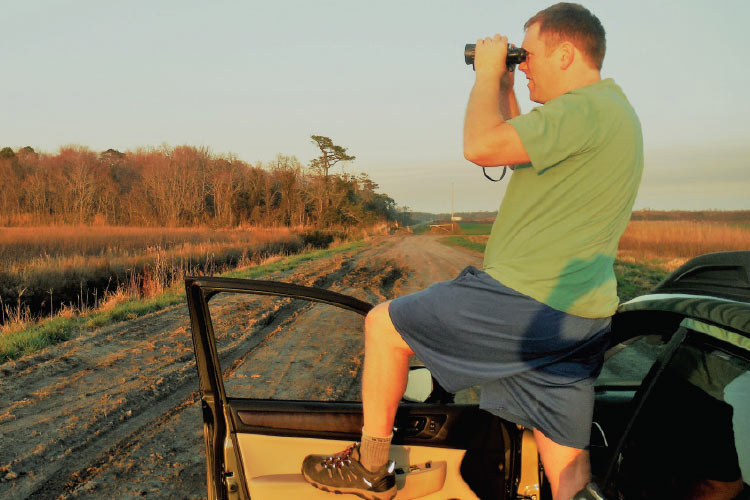
The Comeback
This is especially disappointing to activists because for decades the service touted red wolf reintroduction as a groundbreaking victory.
After the passage of the 1973 Endangered Species Act and before the species was declared extinct in the wild in 1980, Fish and Wildlife captured 400 of the last remaining red wolves from coastal Louisiana and Texas. Fourteen wolves, meticulously scrutinized and selected as the most representative of their kind, were chosen as the founders of an ongoing captive breeding program that now holds about 200 wolves at zoos and other facilities across the country.
The first of these cage-raised animals were released in 1987 at Alligator River, selected for its remote location and the absence of the wolf’s close relative and competitor, the coyote. According to the Fish and Wildlife website, it was “the first time in this nation’s history that a federally listed species was reintroduced to the historic range from which it had been extirpated.”
The program pioneered techniques that helped build the population from the original eight wolves to its peak in 2007. These included the introduction into wild litters of weeks-old, captive-born pups, which were often adopted and raised to adulthood by breeding pairs. And, after coyotes began to spread onto the 1.7 million-acre, five-county wolf reintroduction zone in the 1990s, the program started capturing and sterilizing the smaller animals to serve as “placeholders.” This proved to limit breeding between coyotes and wolves and discourage intrusion by fertile coyotes, a species hard-wired to detect and advance into unoccupied territory.
“There were multiple scientific reviews of the placeholder theory, and they found it to be extraordinarily successful,” Weaver says.
“It was all learning as you go, but we developed a blueprint that was applied to a lot of other programs,” says David Rabon, a former federal wildlife biologist who started helping with the program in 1999 and served as recovery coordinator from 2009 to 2014.
A faded sign outside the temporarily shuttered Red Wolf Education Center in Columbia, just west of Alligator River, proclaims the program “A Howling Success,” and lists its many benefits: controlling the exotic nutria that destroy crops and the raccoons that kill ground-breeding birds; promoting the health of the deer herd by preying on weak and sick animals; and drawing tourists eager to see endangered wolves.
“Why are we not proud of that?” asks Kim Wheeler, executive director of the Red Wolf Coalition. “I don’t know why the state of North Carolina is not saying, ‘Come see the only population of red wolves in the world!’ Why is the state not shouting from the rooftops?”
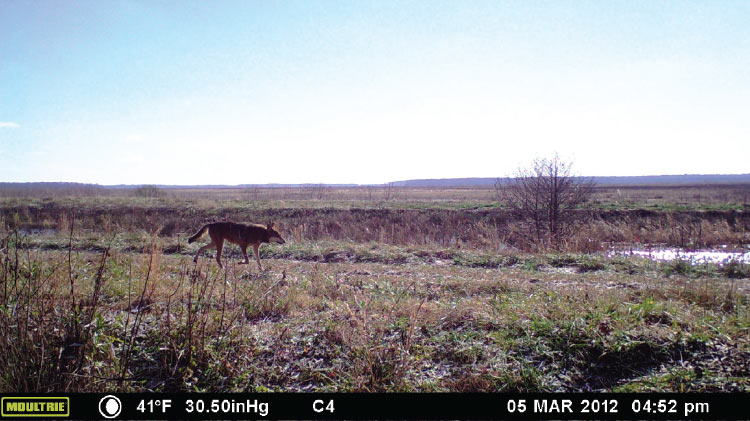
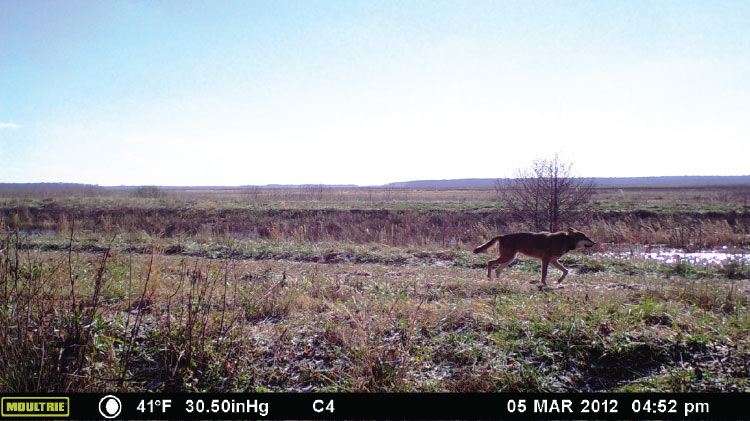
The Opposition
Far from bragging about the wolves, activists say, the North Carolina Wildlife Resources Commission further exposed them to the same threat that wiped them out in the first place, what scientists call “gunshot mortality.”
A 2007 spike in the number of wolves shot and killed by hunters was blamed partly on abundance; there were just more of them to kill. But these deaths remained high through 2013, when hunters killed nine wolves, even as the wolf population declined. These killings drove the decline far beyond the direct loss of animals felled by bullets. Because many were breeding adults, their deaths left unattached mates unable to produce young and more likely to breed with coyotes.
“If you had 12 to 15 packs on the ground, you were losing a third to a half of the breeding pairs per year,” Rabon says. “It was just unsustainable.”
Grim as the findings were, the scientists who wrote the study said it pointed to a clear solution. “USFWS should enhance recovery by providing information and education about red wolves to hunters and the general public.”
North Carolina Wildlife Resources Commission, however, was sending a different message.
In 2012, the agency allowed night hunting of coyotes throughout the state, saying it needed to provide landowners “more tools” to manage the animals on their property—even though science has shown hunting fails to control the species’ advance.
Because most wolves are killed by hunters who mistake them for coyotes, or at least claim to, the Southern Environmental Law Center sued N.C. Wildlife Resources Commission on behalf of three environmental groups, arguing that hunting would result in more deaths of a federally endangered animal. The N.C. Wildlife Resources Commission lawyers have argued that wolves were already adequately protected by the captive breeding program and that this “experimental and non-essential” wild population didn’t deserve the full protection of the Endangered Species Act.
After the federal judge sided with the wolf advocates in 2014, issuing an injunction to temporarily stop coyote hunting in the reintroduction zone and the two sides reached a settlement banning night hunting there, N.C. Wildlife Commission ramped up its opposition.
In 2015, it issued resolutions asking U.S. Fish and Wildlife to remove the wolves from the wild, declare the species extinct and “terminate the Red Wolf Reintroduction Program for free-ranging red wolves in North Carolina.”
It’s not hard to trace the forces behind this stance, Sutherland said. As Republicans gained power in the state, including taking control of both the governor’s office and the legislature in 2012, politicians appointed commissioners who were more conservative and more likely to listen to activist hunters such as developer Jett Ferebee, who owns a large farm in the recovery zone.
Ferebee, who didn’t respond to interview requests, has relentlessly pushed the idea that wolves are a menace to wildlife, writing in a 2014 guest column on an eastern North Carolina news website, The County Compass, that wolves had wiped out deer on his farm, where they were once so numerous his children called it “the Zoo.” The $30 million program, he continued, is a prime example of government intrusion and waste, and the species, never pure to begin with, had become a hopelessly hybridized “coywolf.”
In an interview with Blue Ridge Outdoors, N.C. Wildlife Resources Commission Executive Director Gordon Myers denied political influence and said the resolutions were “absolutely based on science.”
And neither he nor the resolutions repeat Ferebee’s claim about declining deer populations—the main complaint of landowners—which was discounted by a 2013 Fish and Wildlife analysis of state deer hunting statistics. These numbers, the report concluded, “suggest either a flat rate of harvest or an increase from the time of the first wolf releases…through 2013.”
Federal documents, meanwhile, support the commission’s claim that Fish and Wildlife expanded the program beyond its original scope.
Opponents of reintroduction convinced the Department of Interior to look into this question in 2015. Investigators with the department’s Auditor General’s Office noted that the agency had been careful to obtain permission from the owners of farms where the agency introduced pups and performed coyote sterilizations. But it also concluded the program “released more wolves than it originally proposed.”
There is less support, however, for another of Myers’ claims, that “hybridization is really the existential threat to red wolves in the wild.”
A 2015 report on the genetic analysis of scat in the recovery zone estimated hybrids account for only 4 percent of red wolf population. And in 2014, a review of birth records found “over four times as many red wolf litters as hybrid litters over a 13-year time period.”
The findings are really no surprise, Sutherland says: “Wolves prefer to mate with other wolves.”
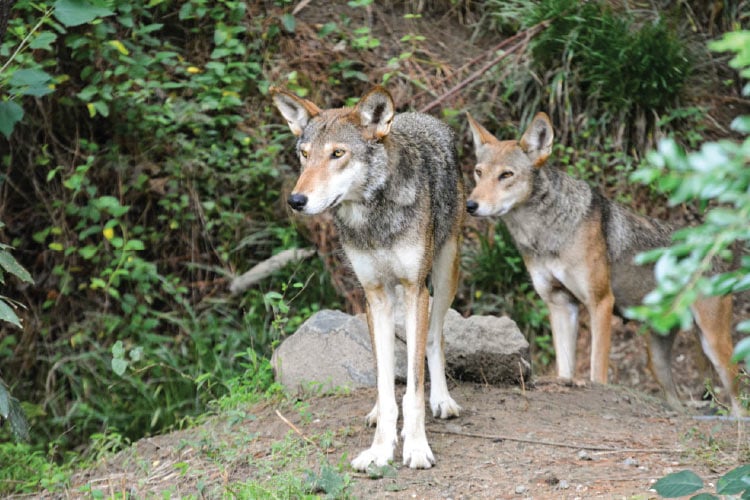
The Genetics
Are they really wolves?
It’s a question that has undermined public support from the start, and an especially damning, headline-grabbing report was released in 2016 by a team led by a Princeton University researcher. It determined that all North American wolves are more closely related to coyotes than previously believed, traceable to a common ancestor as recently as 50,000 years ago. The red wolf, these scientists found, was an even more recent “admixture” of the two species, and really mostly coyote.
Because this issue has been the subject of dueling scientific inquiries for decades, wolf advocates had plenty of other studies to point to. Some researchers have found that bones of current wolves compare closely to fossilized wolf remains from the region, while others have determined that, despite the animals’ similarities, wolves and coyotes look to be, and function as, different species. Red wolves, which top out at about 80 pounds, are nearly twice as big as coyotes, and are far more likely to hunt big animals, especially deer. Based partly on this information, a group of scientists convened by Fish and Wildlife in 2016 unanimously agreed the red wolf was distinctive enough to retain endangered species status.
How much support this debate has bled from the program is another murky matter, partly because the two sides also can’t agree whether lack of support is a problem.
In a 2016 poll, a solid majority of respondents statewide and in the reintroduction zone approved of the recovery program. And when the Fish and Wildlife put out a call for public input about the program last summer, 99.8% of all respondents favored the species’ preservation in the wild. Of the 55,000 comments received, only 10 opposed the program.
But in Columbia, N.C., residents tend to be all for hunting and suspicious of the federal government, said Tim Nielsen, owner of Maggie Duke Antiques on the town’s sleepy, historic Main Street.
He supports the program, saying it provides a much-needed tourist draw, but adds that “everybody hates it. People are pissed off that tax money is involved and they think it’s a foolish endeavor. I kind of agree with that because…from what I understand, the red wolf is genetically identical to the coyote.”
Mike Johnson, who cooperated with FWS scientists on the 10,000 acres of private hunting land managed by his company, Coastal Wildlife Consultants, said he is “neither a friend nor a foe of red wolves.”
But because of their uncertain origin, he gets no thrill from seeing them in the wild, he says. “A pure-bred red wolf is a good-looking animal, but so is a zebra.”
Fish and Wildlife still asserts the red wolf is a distinct species, but as opposition mounted, it steadily retreated from protecting wild wolves.
It has cut the program’s staff and, in 2014, reassigned Rabon, who later left the agency in discouragement. In 2015, it issued a permit that resulted in the killing of a lactating mother wolf and put an end to the pup-fostering and coyote-sterilization initiatives. And in 2016, it announced plans to consider a drastic downsizing, limiting wild wolves to the 160,000-acre Alligator River Refuge and the adjacent Dare County Bombing Range—historically home to only one pack of about 15 animals.
The reason Fish and Wildlife cited for the downsizing—that it needed to focus on propping up the imperiled captive wolf population—was immediately discredited by authors of the scientific study on which it relied. Fish and Wildlife, the scientists said, had based this announcement on several “alarming misinterpretations” of their work.
Fish and Wildlife’s latest announcement in June could finalize the downsizing of territory and also declares open season on young wolves who naturally seek new territory as they mature.
“I don’t think any of us imagined that they would lift restrictions on killing wolves outside of the area,” says Ben Prater, Defenders of Wildlife’s Southeast program director. “This is a stunning and very cruel fate to propose for these red wolves that North Carolinians have expressed overwhelming support for.”
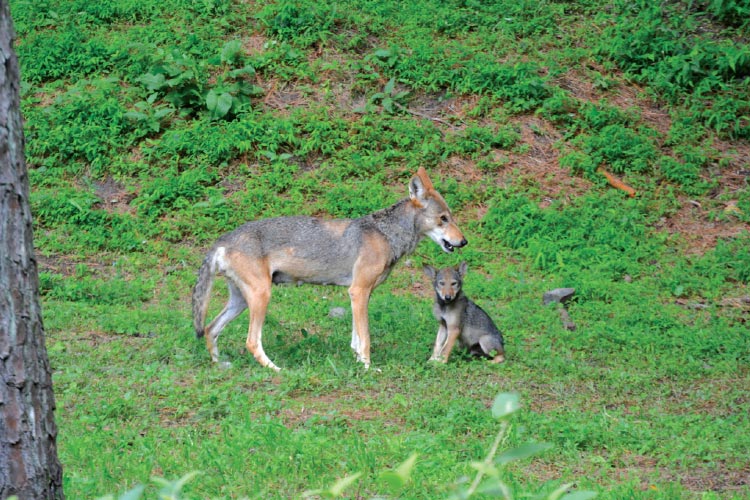
The Irony
Environmentalists point to a central irony in such anti-wolf actions: they are likely to bring about exactly the results that opponents of the restoration program have railed against.
Ferebee and his allies claim to be anti-coyote, but shrinking the range of the wolves and ending the placeholder program gives coyotes free rein, Rabon says. “We have seen, on several occasions, red wolves kill coyotes…The red wolves kept the coyotes at bay.”
Reintroduction opponents also decry the waste of tax money, but the real waste would be abandoning a program built on an unusually efficient investment of government funds. The $800,000 to $1.2 million spent annually on the recovery program leveraged as much as 20 times that amount in commitments from conservation groups and the “40-plus sites” that breed the captive wolves, Rabon said, adding that these sites may be less likely to cooperate if they don’t see this work as supporting a wild population.
About the only aim the critics seem to be accomplishing, wolf advocates say, is ridding a region of its landmark predator and ending an opportunity to restore the natural order that existed before the arrival of European settlers.
Hearing and seeing wolves, Sutherland says, “makes you feel like there’s a place of wild America that we have maintained or, in this case, a piece of wild America that we have recreated, and I just don’t want to lose that.”
Still A Fighting Chance
Sign the petition to stop the U.S. Fish & Wildlife’s proposal to reduce red wolf habitat by 90 percent and allow red wolves to be shot by private landowners.
Red Wolf Myths + Facts
Myth: “The red wolf is nothing but a gray wolf or coyote hybrid.”
FACT: Since 2000, genetic tests have been able to distinguish red wolves from coyotes. The U.S. Fish & Wildlife Service, the agency responsible for managing all endangered species, reaffirmed that red wolves are a separate species last year.
Myth: “The red wolf is a hopeless case now that the coyote has taken over its former range.”
FACT: The red wolf recovery program flourished for 30 years and effectively reduced coyotes within the red wolf’s range. When 150 red wolves roamed the landscape, coyote hybridization rarely occurred. Hybridization with coyotes only began occurring when red wolf populations were drastically diminished by gunshot mortality and fewer wolves were available for reproduction.
Myth: “Red wolves have inflicted great damage to deer and other game species.”
FACT: The red wolf recovery area is home to plentiful populations of deer, turkey, and other wildlife, and the region offers some of the foremost wildlife viewing opportunities in the eastern U.S. Deer populations have remained steady in the red wolf recovery area, and both the U.S. Fish & Wildlife Service and even the North Carolina Wildlife Resources Commissions have acknowledged that deer populations have not been negatively affected by red wolves.
Myth: “We can pull the wild red wolves from North Carolina and keep the species safe in zoos.”
FACT: Living and breeding in encaged environments for too many generations will lead to genetic erosion. The long-term health and viability of red wolves will be jeopardized without a wild population on the landscape. The goal of the Endangered Species Act is to recover species in the wild.
Myth: “People don’t support red wolf recovery, particularly people who live in the red wolf recovery area in eastern North Carolina.”
FACT: Over 99.8% of the 55,000 comments received by the U.S. Fish and Wildlife Service supported the red wolf recovery program. Only 10 comments opposed the program. A vast majority of North Carolinians support red wolf recovery according to a 2016 survey.
